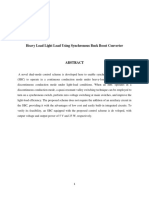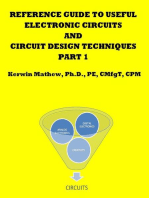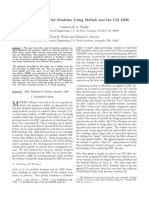Power Electronics Notes
Power Electronics Notes
Uploaded by
prasad357Copyright:
Available Formats
Power Electronics Notes
Power Electronics Notes
Uploaded by
prasad357Original Description:
Copyright
Available Formats
Share this document
Did you find this document useful?
Is this content inappropriate?
Copyright:
Available Formats
Power Electronics Notes
Power Electronics Notes
Uploaded by
prasad357Copyright:
Available Formats
The field of power electronics is concerned with the processing of electrical power using electronic devices.
The key element is the switching converter. it handles power receive power from a source, convert it so that it will be useful for destination(target) ckt.conversion meansconversion of ac/dc to ac/dc conversion of voltage levels conversion of power levels It is not a logical ckt it is not a controlling ckt it is not a communication ckt In a dcdc converter, the dc input voltage is converted to a dc output voltage having a larger or smaller magnitude, possibly with opposite polarity or with isolation of the input and output ground references.-why isolation? an acdc rectifier, an ac input voltage is rectified, producing a dc output voltage. The dc output voltage and/or ac input current waveform may be controlled. The inverse process, dcac inversion, involves transforming a dc input voltage into an ac output voltage of controllable magnitude and frequency. Acac cycloconversion involves converting an ac input voltage to a given ac output voltage of controllable magnitude and frequency. It is nearly always desired to produce a well-regulated output voltage, in the presence of variations in the input voltage and load current. A controller block is an integral part of any power processing system. The efficiency of a converter having out put power
Pout
and input power
Pin is
Pout Pin
1 Ploss Pout ( 1)
quiz 1):at what efficiency output power equals loss of power? quiz 2)if the converter efficiency is 90%, then the converter loss power is equal to only ---% of the output power.(ans 11%)
This lost power is converted into heat, which must be removed from the converter. If the output power is substantial, then so is the loss power. This leads to a large and expensive cooling system, it causes, the electronic elements within the converter , to operate at high temperature, and it reduces the system reliability. Indeed, at high output powers, it may be impossible to adequately cool the converter elements using current technology. Increasing the efficiency is the key to obtaining higher output powers. Efficiency is a good measure of the success of a given converter technology. Since very little power is lost, the converter elements can be packaged with high density, leading to a converter of small size and weight, and of low temperature rise. the challenge: How can we build a circuit that changes the voltage, yet dissipates negligible power? The various conventional circuit elements for voltage conversion: resistive elements, capacitive elements,
magnetic devices including inductors and transformers, semiconductor devices operated in the linear mode (for example, as class A or class B amplifiers), and semiconductor devices operated in the switched mode (such as in logic devices where transistors operate in either saturation or cutoff). In conventional signal processing applications, where efficiency is not the primary concern, magnetic devices are usually avoided wherever possible, because of their large size and the difficulty of incorporating them into integrated circuits. In contrast, capacitors and magnetic devices are important elements of switching converters, because ideally they do not consume power. It is the resistive element, as well as the linear-mode semiconductor device, that is avoided. Switched-mode semiconductor devices are also employed. When a semiconductor device operates in the off state, its current is zero and hence its power dissipation is zero. When the semiconductor device operates in the on (saturated) state, its voltage drop is small and hence its power dissipation is also small. In either event, the power dissipated by the semiconductor device is low. So capacitive and inductive elements,as well as switched-mode semiconductor devices, are available for synthesis of high-efficiency converters. design: The input voltage is 100 V. It is desired to supply 50 V to an effective load impedance of 5. 1)using series resistor 2) linear-mode power transistor 3)switched mode semiconductor devices what are the drawbacks?-compare efficiency,loss and regulation.(dependency of output voltage on the load current and load impedence) give part nos of selected resistors and transistors. In addition to the desired dc component the switch output voltage waveform also contains undesirable harmonics of the switching frequency. To remove these harmonics a low-pass filter can be employed . introduction of a single-section LC lowpass filter. If the filter corner frequency is sufficiently less than the switching frequency then the filter essentially passes only the dc component of To the extent that the switch, inductor, and capacitor elements are ideal, the efficiency of this dcdc converter can approach 100%. Design:An L-C low pass filter if the switching frequency is 1k.why there is a free wheeling diode? The converter power stage developed is called the buck converter, because it reduces the dc voltage. a control system is introduced for regulation of the output voltage. Since the output voltage is a function of the switch duty cycle, a control system can be constructed that varies the duty cycle to cause the output voltage to follow a given reference. error signal= reference voltage- output voltage->pulse width modulator The boost converter, in which the positions of the inductor and SPDT switch are interchanged. This converter is capable of producing output voltages that are greater in magnitude than the input voltage. In general, any given input voltage can be converted into any desired output voltage, using a converter containing switching devices embedded within a network of reactive elements.(how?) ina simple inverter circuit,dc is converted to ac, the switch duty cycle is modulated sinusoidally. This causes the switch output voltage to contain a lowfrequency sinusoidal component. The LC filter cutoff frequency is selected to pass the desired lowfrequency components of but to attenuate the high-frequency switching harmonics. The controller modulates the duty cycle such that the desired output frequency and voltage magnitude are obtained.
You might also like
- 1000w Inverter PURE SINE WAVE Schematic DiagramDocument153 pages1000w Inverter PURE SINE WAVE Schematic Diagramjeevapillay100% (4)
- Maintenance Procedure For Substations and SwitchgearDocument7 pagesMaintenance Procedure For Substations and Switchgearnana rustianaNo ratings yet
- Study and Design, Simulation of PWM Based Buck Converter For Low Power ApplicationDocument17 pagesStudy and Design, Simulation of PWM Based Buck Converter For Low Power ApplicationIOSRjournalNo ratings yet
- Study of AC and-WPS OfficeDocument6 pagesStudy of AC and-WPS OfficeBeena PalNo ratings yet
- Buck ConverterDocument52 pagesBuck Convertermayankrkl50% (2)
- Has High Efficiency. Fault Current Is Limited by The Inductor Output Short Circuit Current Is Easy To ImplementDocument6 pagesHas High Efficiency. Fault Current Is Limited by The Inductor Output Short Circuit Current Is Easy To ImplementRajalakshmi ShivakumarNo ratings yet
- Lab 2 Buck ConverterDocument3 pagesLab 2 Buck ConverterShah VinodNo ratings yet
- Regulated DC Power SupplyDocument15 pagesRegulated DC Power SupplynalumilanimeNo ratings yet
- High Power Topology: "AlbacomDocument7 pagesHigh Power Topology: "AlbacomRaveendhra IitrNo ratings yet
- Converter Vs InverterDocument8 pagesConverter Vs InverterPrasad ChandramohananNo ratings yet
- Ee 328 Lecture 1Document40 pagesEe 328 Lecture 1Hasan Hatice IlcalıNo ratings yet
- Ass 2 Wind0.02Document25 pagesAss 2 Wind0.02Šämęh ËšśämNo ratings yet
- 9.eee Ijeee Two Phase Interleaved DC SumalathaDocument16 pages9.eee Ijeee Two Phase Interleaved DC Sumalathaiaset123No ratings yet
- Journal ScientificDocument5 pagesJournal Scientificrikaseo rikaNo ratings yet
- High-Power Density Design of A Soft-Switching High-Power Bidirectional DC-DC ConverterDocument9 pagesHigh-Power Density Design of A Soft-Switching High-Power Bidirectional DC-DC Convertermurthy237No ratings yet
- How An Smps Works: Rectifier StageDocument7 pagesHow An Smps Works: Rectifier StageImran AshrafNo ratings yet
- How An SMPS WorksDocument7 pagesHow An SMPS WorksĐorđe PopovićNo ratings yet
- First Quadrant Single Phase Ac To DC Converter Semiconverter Separately Excited DC MotorDocument9 pagesFirst Quadrant Single Phase Ac To DC Converter Semiconverter Separately Excited DC MotorzaidNo ratings yet
- BOOK-2, NEW LastDocument38 pagesBOOK-2, NEW Lastkishoregym5No ratings yet
- English of Buckboost Revisi FinishDocument12 pagesEnglish of Buckboost Revisi FinishdharmaarindraNo ratings yet
- Heavy Load Light Load Conversion ReportDocument41 pagesHeavy Load Light Load Conversion ReportSanjivee SachinNo ratings yet
- InverterDocument18 pagesInverterHebatallah FaisalNo ratings yet
- Sem ReportDocument38 pagesSem ReportSafalsha BabuNo ratings yet
- Effect of Source InductanceDocument25 pagesEffect of Source InductanceSriram Anil Kumar Gandham100% (1)
- 3 Level InverterDocument63 pages3 Level InverterThirumal ValavanNo ratings yet
- Reference Guide To Useful Electronic Circuits And Circuit Design Techniques - Part 1From EverandReference Guide To Useful Electronic Circuits And Circuit Design Techniques - Part 1Rating: 2.5 out of 5 stars2.5/5 (3)
- DC-DC ConverterDocument12 pagesDC-DC ConvertersabariNo ratings yet
- Topic Assignment14Document6 pagesTopic Assignment14cuongakamarineNo ratings yet
- 689-Article Text-2322-1-10-20160621Document7 pages689-Article Text-2322-1-10-20160621AfifNasirNo ratings yet
- Ijet V2i2p17Document9 pagesIjet V2i2p17International Journal of Engineering and TechniquesNo ratings yet
- Power Electronics FinalDocument470 pagesPower Electronics FinalAyushmaan100% (1)
- High-Efficiency, High Step-Up DC-DC ConvertersDocument9 pagesHigh-Efficiency, High Step-Up DC-DC ConvertersC_hakan_CNo ratings yet
- High Efficiency Power Conversion Using A Matrix Converter: Jun-Ichi Itoh Akihiro Odaka Ikuya SatoDocument0 pagesHigh Efficiency Power Conversion Using A Matrix Converter: Jun-Ichi Itoh Akihiro Odaka Ikuya Satomenilanjan89nLNo ratings yet
- A Novel Soft-Switching Single-Phase AC-DC-AC Converter Using New ZVS-PWM StrategyDocument2 pagesA Novel Soft-Switching Single-Phase AC-DC-AC Converter Using New ZVS-PWM Strategyskumar_61719No ratings yet
- Switched Mode Power SupplyDocument153 pagesSwitched Mode Power SupplyIvan222244No ratings yet
- CS CepDocument8 pagesCS Cepfaizan habibNo ratings yet
- Modeling and Simulation of Bidirectional Ac-Dc Power ConverterDocument4 pagesModeling and Simulation of Bidirectional Ac-Dc Power ConverterKalyan Reddy AnuguNo ratings yet
- High-Efficiency Hybrid Resonant Converter With Wide-Input Regulation For Photovoltaic Applications-1Document76 pagesHigh-Efficiency Hybrid Resonant Converter With Wide-Input Regulation For Photovoltaic Applications-1VINAYNo ratings yet
- Emergency Lighting Fluorescent Lamp: AbstractDocument20 pagesEmergency Lighting Fluorescent Lamp: AbstractAakash SheelvantNo ratings yet
- Theory of Switched Mode Power SupplyDocument21 pagesTheory of Switched Mode Power Supplyseahate100% (2)
- Novel Loaded-Resonant Converter For Application of DC-to-DC Energy ConversionsDocument7 pagesNovel Loaded-Resonant Converter For Application of DC-to-DC Energy ConversionsInternational Journal of Application or Innovation in Engineering & ManagementNo ratings yet
- A DC-to-DC Converter. With Assignment Questions at The EndDocument19 pagesA DC-to-DC Converter. With Assignment Questions at The EndPascal UZABAKIRIHONo ratings yet
- Report On Power SupplyDocument14 pagesReport On Power SupplyBhavesh MaheshwariNo ratings yet
- Ecce 2018 8558336Document6 pagesEcce 2018 8558336mosiurrahmanjony16No ratings yet
- High Efficient Asynchronous Buck Converter For Biomedical DevicesDocument7 pagesHigh Efficient Asynchronous Buck Converter For Biomedical DevicesresearchinventyNo ratings yet
- Unit - 5 PDFDocument19 pagesUnit - 5 PDFShock SignalNo ratings yet
- Two-Stage H-Bridge Transformer Coupled DC-DC Converter With Zero Voltage SwitchingDocument8 pagesTwo-Stage H-Bridge Transformer Coupled DC-DC Converter With Zero Voltage SwitchingRakeshconclaveNo ratings yet
- A State Space Modeling of Non-Isolated BidirectionDocument11 pagesA State Space Modeling of Non-Isolated BidirectionabdullahshahidNo ratings yet
- Reference Guide To Useful Electronic Circuits And Circuit Design Techniques - Part 2From EverandReference Guide To Useful Electronic Circuits And Circuit Design Techniques - Part 2No ratings yet
- STEM: Science, Technology, Engineering and Maths Principles Teachers Pack V10From EverandSTEM: Science, Technology, Engineering and Maths Principles Teachers Pack V10No ratings yet
- Power Electronics and Energy Conversion Systems, Fundamentals and Hard-switching ConvertersFrom EverandPower Electronics and Energy Conversion Systems, Fundamentals and Hard-switching ConvertersNo ratings yet
- Static-Inverter 1.0: A Complete Design Process to Convert D.C. to A.C. Electricity Using the Astable-MultivibratorFrom EverandStatic-Inverter 1.0: A Complete Design Process to Convert D.C. to A.C. Electricity Using the Astable-MultivibratorNo ratings yet
- Power Systems-On-Chip: Practical Aspects of DesignFrom EverandPower Systems-On-Chip: Practical Aspects of DesignBruno AllardNo ratings yet
- Tantalo AsympDocument8 pagesTantalo AsympNikhil SharmaNo ratings yet
- Ba5406 PDFDocument5 pagesBa5406 PDFprasad357No ratings yet
- Audio Circuits Using The NE5532/3/4Document12 pagesAudio Circuits Using The NE5532/3/4kurtm22No ratings yet
- Making DSP Fun For Students Using Matlab and The C31 DSK: Cameron H. G. WrightDocument10 pagesMaking DSP Fun For Students Using Matlab and The C31 DSK: Cameron H. G. Wrightprasad357No ratings yet
- Transmission Lines at Audio Frequencies, and A Bit of HistoryDocument3 pagesTransmission Lines at Audio Frequencies, and A Bit of Historyprasad357No ratings yet
- Fluentu The Fascinating Origins of 16 Common English WordsDocument7 pagesFluentu The Fascinating Origins of 16 Common English Wordsprasad357No ratings yet
- Designing Amplifiers With Tripath'S High-Power Class-T DriversDocument9 pagesDesigning Amplifiers With Tripath'S High-Power Class-T Driversprasad357No ratings yet
- Mc2 Application Note 100v Line TheoryDocument5 pagesMc2 Application Note 100v Line Theoryprasad357No ratings yet
- Cloud CXL-100T Manual V2Document4 pagesCloud CXL-100T Manual V2prasad357No ratings yet
- TF 407 & TF 410 Installation Manual: DescriptionDocument2 pagesTF 407 & TF 410 Installation Manual: Descriptionprasad357No ratings yet
- QkeypadmDocument5 pagesQkeypadmprasad357No ratings yet
- Per Unit CalculationsDocument7 pagesPer Unit Calculationsanbuelectrical100% (1)
- Assignment-3: Subject: B.Tech - VII Sem ElectricalDocument2 pagesAssignment-3: Subject: B.Tech - VII Sem ElectricalVineet KoundalNo ratings yet
- Reliability Investigation and Evaluation of Off-Grid Solar Photovoltaic (PV) Power SystemDocument16 pagesReliability Investigation and Evaluation of Off-Grid Solar Photovoltaic (PV) Power SystemAwoyinka Tunde DareNo ratings yet
- EMS Lab3 - 2 - 04Document15 pagesEMS Lab3 - 2 - 04Jegan PrasadNo ratings yet
- 1A Adjustable Voltage High Speed LDO Regulators ME6118 SeriesDocument17 pages1A Adjustable Voltage High Speed LDO Regulators ME6118 Seriesdavid suwarno sukartoNo ratings yet
- Ee8401 - em Ii - Question Bank - Unit4Document4 pagesEe8401 - em Ii - Question Bank - Unit4DEVINo ratings yet
- Koodankulam Nuclear Power PlantDocument15 pagesKoodankulam Nuclear Power PlantEdgardo SimpsonNo ratings yet
- M-Yd Series: Fujian Runda Power Machinery Co., LTDDocument4 pagesM-Yd Series: Fujian Runda Power Machinery Co., LTDTrần Đại Hải PhúcNo ratings yet
- Electrical Systems Design: Data Handbook, 1/e: Book Information Sheet Book Information SheetDocument3 pagesElectrical Systems Design: Data Handbook, 1/e: Book Information Sheet Book Information SheetDevi ChaitanyaNo ratings yet
- 1606 sr008 - en e PDFDocument23 pages1606 sr008 - en e PDFJuan Erwin Ccahuay HuamaniNo ratings yet
- Service Manual: Freestanding Cooling Table Top ARC 0060Document5 pagesService Manual: Freestanding Cooling Table Top ARC 0060Sergio ZapataNo ratings yet
- ELEC3206 9206 2016s2 Module 00 Overview SlidesDocument13 pagesELEC3206 9206 2016s2 Module 00 Overview SlidesNamerNo ratings yet
- PHD ProposalDocument7 pagesPHD Proposalsani musa100% (2)
- OVF-10 Basic DataDocument48 pagesOVF-10 Basic DataaaditsivaprakashNo ratings yet
- Siemens Vacumm Contactor 3tl6Document15 pagesSiemens Vacumm Contactor 3tl6Yong Ee VonnNo ratings yet
- Monitoring With Communication Technologies of The Smart GridDocument11 pagesMonitoring With Communication Technologies of The Smart GridKampala International UniversityNo ratings yet
- Iq 7plus Acm Ds en UsDocument2 pagesIq 7plus Acm Ds en UsdahdahNo ratings yet
- 75kW-600kW ZJR2 Series Soft StarterDocument20 pages75kW-600kW ZJR2 Series Soft Startermensun19No ratings yet
- PDF PDFDocument2 pagesPDF PDFVastie RozulNo ratings yet
- Profile PT MPMDocument18 pagesProfile PT MPMShalahuddin HasanNo ratings yet
- Types of Electrical Protection RelayDocument6 pagesTypes of Electrical Protection RelayAnupam0103No ratings yet
- DVD Player Common TroublesDocument4 pagesDVD Player Common TroublesTobias Lowrence100% (1)
- Aluminum Electrolytic CapacitorsDocument271 pagesAluminum Electrolytic CapacitorsButchNo ratings yet
- PWM & MPPT Solar Charge Controller RangeDocument1 pagePWM & MPPT Solar Charge Controller RangeSystellarNo ratings yet
- RUPTLDocument17 pagesRUPTLNury Rinjani100% (1)
- Mled ELP 33: XXX/X/XXX/XX/XXDocument2 pagesMled ELP 33: XXX/X/XXX/XX/XXJaideep SinghNo ratings yet
- Singati Hydro Energy Ltd.Document47 pagesSingati Hydro Energy Ltd.kumarNo ratings yet
- Internship ReportDocument44 pagesInternship ReportMaheen GulNo ratings yet
- Enercon Wind TurbinesDocument33 pagesEnercon Wind Turbinesismail özdamar100% (1)




































































































